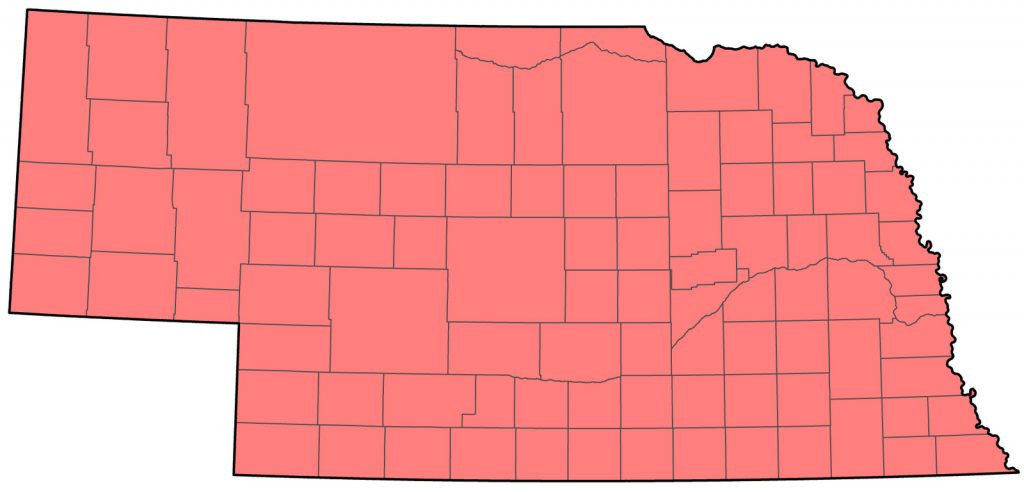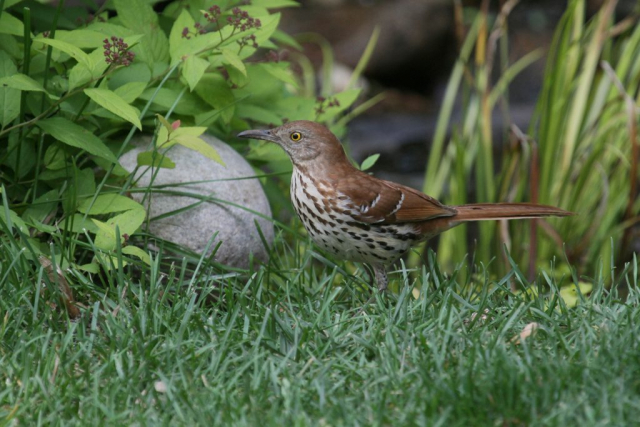Toxostoma rufum LONGICAUDA, T. R. RUFUM
Status: Common regular spring and fall migrant and breeder statewide. Rare casual winter visitor south and southeast.

Documentation: Specimen: rufum, UNSM ZM6643, 17 Sep 1921 Lancaster Co.
Taxonomy: Two subspecies are recognized (AviList 2025), rufum of the eastern US west to western Minnesota, western Iowa, and western Missouri, and longicauda of the western US from south-central Canada south and east to eastern Wyoming, southwestern Nebraska, and eastern Colorado.
Based on AOU (1957) and the Nebraska specimen cited above, eastern rufum occurs in extreme eastern Nebraska and longicauda in the western half of Nebraska; thus, most Nebraska Brown Thrashers are probably intergrades.
A potential Nebraska hybrid with Curve-billed Thrasher is discussed here.
Spring: Mar 22, 22, 22 <<<>>> summer (east and south); Apr 16, 17, 18 <<<>>> summer (north), Apr 23, 23, 25 <<<>>> summer (west)
An earlier date in the north is 14 Apr 2012 Howard Co, and in the west 29 Mar 2020 Sioux Co.
Migrants in the south and east arrive at the end of Mar and spread west over the rest of the state in Apr, with numerous reports in Apr in the Platte River Valley. Arrival is about a month later in the north and west.
- High counts: 161 in Hall Co 11 May 2002, 144 there 13 May 2006, 126 in southeast Nebraska 6 May 2006, and 60 at Kenesaw, Adams Co 26 Apr 1998.
Summer: Brown Thrasher breeds statewide, with lower numbers westward and lowest numbers in the Panhandle.
The range expanded into grasslands of the Great Plains during the late 1800s as European settlers arrived; fire suppression, woody plantings, and the breakup of prairies into fields bordered by fencerows and shelterbelts created optimal habitat for the species (Cavitt and Haas 2020). As agricultural land use has continued to intensify, habitat for this species may be decreasing. BBS trend analysis (Sauer et al 2020) shows an annual decline of -0.94 (95% C.I.; -1.45, -0.44) for 1966-2019. Densities are currently highest for the USA in the central Great Plains, including eastern Nebraska (Cavitt and Haas 2020).
- Breeding phenology:
- Nest building: 24 Apr-18 May
Eggs: 10 May- 22 Jul (Mollhoff 2022)
Nestlings: 13 May-15 Jul
Fledglings: 14 Jun-31 Jul
- High counts: 35 in Cheyenne Co 20 Jun 2022, 25 in Lancaster Co 4 Jun 2013, and 19 in Custer Co 11 Jun 2017.
Fall: summer <<<>>> Oct 10, 10, 11 (west, north, northeast); summer <<<>>> Jan 12, 12, 13 (southeast)
Later dates in the north and west are 20 Oct 2023 Anderson Bridge WMA, Cherry Co, 10 Nov 2023 Carter Canyon, Scotts Bluff Co, and 14 Nov 2000 Oliver Reservoir, Kimball Co. One was tardy westerly in Lincoln Co 4 Nov 2021.
Jan and later reports are far fewer and those after 13 Jan are discussed under Winter.
Departure is gradual, with most birds leaving by late Sep in the Panhandle. Elsewhere, Dec reports are numerous; most reports are from CBCs.
Banding data indicate that Brown Thrashers that summer in Nebraska commonly winter in Texas, and also that in fall some individuals wander northward, at least to South Dakota.
- High counts: 28 at Lincoln Saline Wetlands NP, Lancaster Co 17 Sep 2023, 23 at Cottonmill Park, Buffalo Co 7 Sep 2024, 21 at Lincoln Saline Wetlands NP 24 Sep 2020, and 21 there 18 Sep 2022.
Winter: Documented overwintering is rare, with these few records, all but one in the east: Aurora, Hamilton Co 1957-58 (Jorgensen 2012), Lincoln, Lancaster Co through 9 Mar 2008, York Co 28 Feb through 18 Mar 2019, Scotts Bluff Co 2010-2011, an apparently-injured bird in Madison, Madison Co 2012-2013, one in a Wayne, Wayne Co yard 2 Dec 2023-3 Feb 2024, singles overwintered in Lincoln, Lancaster Co yards 2013-2014, 2016-2017, and 2017-2018, near Lake Cunningham, Douglas Co 28 Dec 2019-29 Jan 2020, Ceresco, Lancaster Co through 16 Feb 2025, and one near Boystown, Douglas Co Dec through 27 Mar 2025.
There are 21 additional reports 14 Jan-21 Mar, most in the southeast, with these elsewhere: 7 Jan 1957 Dawes Co, 7-25 Jan 2024 Wayne Co, 20 Jan 2024 Gering Cemetery, Scotts Bluff Co, 26 Jan 1959 Antelope Co, 1 Feb 2005 Morrill Co, 15 Feb 2020 Buffalo Co, 17 Feb 2024 Gering Cemetery, Scotts Bluff Co, 3-13 Mar 2024 Wayne Co, 10 Mar 2022 Sutherland Reservoir, Lincoln Co, and 18 Mar 2019 Hall Co.
Images
Abbreviations
BBS: Breeding Bird Survey
CBC: Christmas Bird Count
NP: Nature Park
UNSM: University of Nebraska State Museum
Literature Cited
American Ornithologists’ Union [AOU]. 1957. The AOU Check-list of North American birds, 5th ed. Port City Press, Baltimore, Maryland, USA.
AviList Core Team, 2025. AviList: The Global Avian Checklist, v2025. https://doi.org/10.2173/avilist.v2025.
Cavitt, J.F. and C.A. Haas. 2020. Brown Thrasher (Toxostoma rufum), version 1.0. In Birds of the World (A. F. Poole, Editor). Cornell Lab of Ornithology, Ithaca, NY, USA. https://doi.org/10.2173/bow.brnthr.01.
Jorgensen, J.G. 2012. Birds of the Rainwater Basin, Nebraska. Nebraska Game and Parks Commission, Lincoln, Nebraska, USA.
Mollhoff, W.J. 2022. Nest records of Nebraska birds. Nebraska Ornithologists’ Union Occasional Paper Number 9.
Sauer, J.R., W.A. Link and J.E. Hines. 2020. The North American Breeding Bird Sruvey – Analysis Results 1966-2019. U.S. Geological Survey data release, https://doi.org/10.5066/P96A7675, accessed 27 Jul 2023.
Recommended Citation
Silcock, W.R., and J.G. Jorgensen. 2025. Brown Thrasher (Toxostoma rufum). In Birds of Nebraska — Online. www.BirdsofNebraska.org
Birds of Nebraska – Online
Updated 2 Sep 2025

